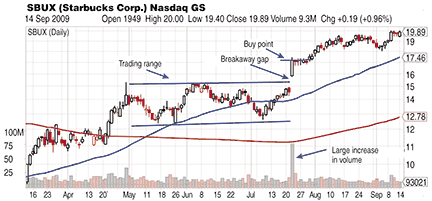CHARTING
Far And Away
Breakaway Gaps
There are many different types of gaps, but this one provides the best risk-reward ratio.
A gap up in a stock’s price is an exciting event. Usually, such moves will be covered by the financial media, creating hysteria and resulting in some people frantically buying the stock “before it’s too late.” Rarely do the pundits provide a reasoned and thorough explanation as to why the large jump in price will lead to any sort of substantial gains over the near future; they just report the awe-inspiring numbers without touching on their technical significance. Sometimes, armed with simply a headline, the uninformed will buy the stock and get lucky. Over the long term, however, this strategy is bound to fail, as a large gap up in price does not necessarily mean the stock will continue to rise. It is possible to trade these large price moves and jump on a profit-making trend, provided you learn to recognize the patterns that are more likely to succeed.
There are various types of gaps including common, runaway, and exhaustion gaps. For our purposes, however, the one we will concern ourselves with is the breakaway. From a trading perspective, it provides the best risk-reward ratio when compared to other price gaps.
Why breakaway gaps occur
Just like gasoline, beachfront property, shoes, or any other commodity, the price of a stock is affected by the forces of supply and demand. If demand is greater than supply, the price of an item will rise. Conversely, if supply is greater than demand, the price of the item will fall. If you are a trend-follower, you may be of the opinion that stock prices generally move up or down in a uniform fashion. However, if a situation has dramatically changed, it may cause the demand to rise or fall, resulting in a stock price gapping up (or down). Some examples of when a breakaway gap may form are an earnings surprise, award of a new government contract, or the possibility of a buyout. Will the stock continue to rise? We can never know for sure, but the charts give us some clues as to whether it might be worth entering a trade and riding the trend.

Figure 1: a classic breakaway gap. After trading in a range for almost three months, the stock gaps up out of the trading range on tremendous volume. In this case, the stock did not provide much of an opportunity to buy before the next rise in price. While the stock did pull back, it did so on lighter volume and stayed near the closing high.